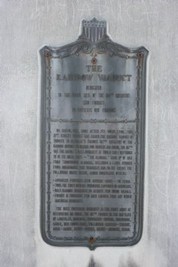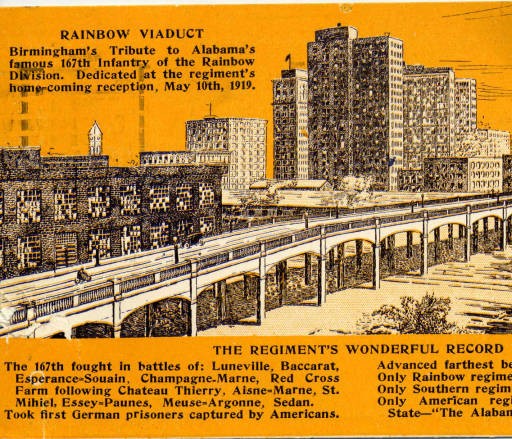The Rainbow Viaduct Marker
Introduction
Text-to-speech Audio
Images
The Marker of the Rainbow Viaduct

The Rainbow Viaduct shown against the city

Backstory and Context
Text-to-speech Audio
General Gouraud said that the “Rainbow” put a new spirit into France. Foch immediately put the victorious Allied Army on the offensive. Four days after winning in the Champagne, he ordered a Franco-American drive northeast from the town of Chateau-Thierry. The 167th (Alabama), with its sister regiment in the 84th Brigade, the168th (Iowa) on its right flank, led the “Rainbow” Division push into a great battle at Croix Rouge Farm on July 26, 1918. There the Alabama regiment lost 162 killed, including 3 Lieutenants and 2 Captains, company commanders. More than 1,000 from the 167th (Alabama) were wounded. But their victory forced the Germans to retreat to positions on the east of the Ourcq River, about six miles from the Croix Rouge Farm.
On the next day, July 27, the weakened 167th (Alabama) and 168th (Iowa) regiments of the 84th Brigade were joined by the “Rainbow’s” fresh 83rd Brigade. Regiments abreast, the full “Rainbow” Division attacked across the Ourcq River on the morning of July 28, and opened the battles on the hills east of the river. Corporal Sidney Manning of Company G of the 167th (Alabama) was recommended for the Congressional Medal of Honor for his heroic work in that morning’s attack.
The regimental operations officer, Captain Mortimer H. Jordan, M.D. was wounded that day and died in a field hospital. Command of F Company, Gadsden, passed twice that morning due to wounds. Command of G. Company, Ozark, passed due to wounds. Command of the combined 1st and 3rd battalions was passed from Major Dallas B. Smith to Captain Ravee Norris. Lieutenant Colonel Bare, regimental executive officer was gassed and evacuated. Major Carroll took over command of the forward PC from him but was wounded. Captain Herman W. Thompson, commanding H Company, was seriously wounded and evacuated.
The 84th Brigade’s commander, Brigadier General Robert A. Brown was relieved during the battle by Colonel Douglas MacArthur on the recommendation of Major General Menoher, commander of the “Rainbow.” The 168th (Iowa) regiment’s commander, Colonel E. R. Bennett, was replaced by Lieutenant Colonel Mathew A. Tinley. An Iowa battalion commander was also replaced.
After four days of hard fighting by both sides, the Germans began a massive retreat toward the Rhine River on August 2, 1918. Casualties in this operation for the “Rainbow” were 184 officers and 5,469 men.
The 42nd Division, reequipped and brought back to full strength, was ordered to take part in the all American attack at St. Mihiel. After more than a week of night marches to the jump off position, the division attacked on September 11, 1918, delivering the main blow in the direction of the heights overlooking the Madine River. Just as at the Croix Rouge Farm, C Company and D Company of the 167th (Alabama) led the “Rainbow” assault force. The attack was a total surprise to the Germans and came at a time when they had begun to retreat. The 167th objective was accomplished by nightfall of the first day. Thirteen American divisions, about half a million men, took part in the highly successful operation.
The Rainbow Viaduct is Dedicated to the Memory of the Jefferson County Members of the 167th Infantry, Rainbow Division of Whom were Killed in Action or Died of Wounds in the World War 1914 - 1918.
